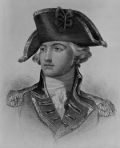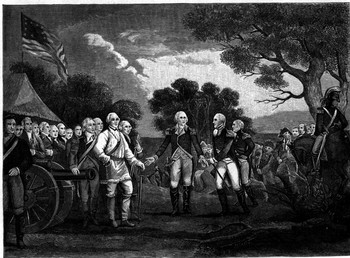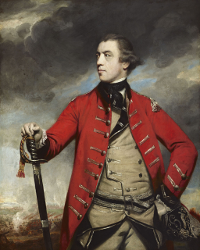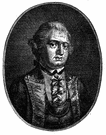John Burgoyne as a major general in the British Army, seeing combat in Europe and in North America. After some initial success, he found defeat at Saratoga. He was born on Feb. 24, 1722, in Sutton, Bedfordshire, England. Some details of his early life are known. He attended Westminster School, along with many future British Army officers, including the onetime North American commander-in-chief Thomas Gage. 
Burgoyne fought for Great Britain in the War of the Austrian Succession and then, later, in the Seven Years War. In between, he married Charlotte Stanley; the couple had one child. He was elected to Parliament in 1761 and held the seat for the rest of his life. He fought in Europe during the Seven Years' War, seeing action in Portugal and off the coast of France. He was referred to affectionately by the men who served with him as "Gentleman Johnny." By the time of the Revolutionary War, he had been promoted to major general. He arrived in Boston in May 1775 and was part of the garrison of troops who were encircled in Boston. Burgoyne found success in Canada, sailing up the St. Lawrence River and breaking the Continental Army's siege of Quebec. He then convinced King George III and his government to support a plan of divide and conquer, to gain control of Lake Champlain and the Hudson River Valley of the state of New York. According to Burgoyne, the principal author of the plan, it would work thus:
That was the plan. Things did not go to plan. For a start, all orders still had to go through Lord Germain, back in Great Britain, and communications took time to cross the Atlantic. Everyone was clear on the plan; but somewhere along the way, Howe decided that he wanted to seize Philadelphia, the colonies' capital, instead, and so did not send his large force north up the Hudson River. Another general, Henry Clinton, did march on Albany but with a much smaller force than had been agreed on by all. St. Leger, meanwhile, was having a tough time of it as well. He had chosen to begin a siege of Fort Stanwix, on the Mohawk River. St. Leger was successful at first, but a relief force led by American General Benedict Arnold managed to convince St. Leger that time had come to abandon what to him must have seemed a foolhardy mission and return to the friendly confines of Canada. Burgoyne, not knowing any of this until much later, continued on toward Albany, his force reduced to 6,000 through a combination of defeats, disease, and desertions. When Burgoyne reached the outskirts of Howe did end up occupying Philadelphia, on Sept. 26, after dispatching the troops of George Washington yet again, at Brandywine. Clinton did end up traversing the Hudson River and scored a small victory, burning the Colonial Army capital at Kingston, but he didn't arrive in Albany for many a day. By October, the Colonial Army at Saratoga was very large indeed, numbering about 11,000, nearly twice that of Burgoyne's. The British general was firmly convinced by this time that help from his own forces was indeed not coming. He had no doubt received messages from St. Leger, Howe, and Clinton and determined that he was on his own, as far as the British Army was concerned. He had also believed reports that Native American and Loyalists in the area would rise up and join the Redcoats when they arrived; none did. With no way out, Burgoyne chose to fight. 
The battle began on October 7 and lasted a full 10 days (much longer than the Americans probably had anticipated). Charge followed charge, counterattack followed attack, and the result was the smashing American victory that Washington, Gates, and all the other American generals had been hoping for for a few years. Burgoyne surrendered himself and his entire force, giving up claims to New York and abandoning his great quest to remove New England from the American sphere of influence. Things went from bad to worse for Britain, as news came that France had decided to ally with the Americans. Burgoyne returned home, to defend himself. He found himself on the right side of the political spectrum when a new government swept into power in 1782; Burgoyne was made commander-in-chief in Ireland and made a privy councillor. All of that disappeared the very next year, when the government was replaced. He led a relatively private life after that. He died Aug. 4, 1792, in London. One thing not so well-known about Burgoyne is that he was a successful playwright. He wrote The Maid of the Oaks in 1774 and The Heiress in 1786 and worked with the famous playwright Richard Brinsley Sheridan on one of his productions. Burgoyne also did some work in opera. |
|
Social Studies for Kids
copyright 2002–2025
David White



 He would lead a force across Lake Champlain from Quebec, take Fort Ticonderoga, then march on to Albany, N.Y.
He would lead a force across Lake Champlain from Quebec, take Fort Ticonderoga, then march on to Albany, N.Y. Saratoga in mid-September, he saw before him a Colonial army numbering more than 8,000 men and commanded by
Saratoga in mid-September, he saw before him a Colonial army numbering more than 8,000 men and commanded by 
